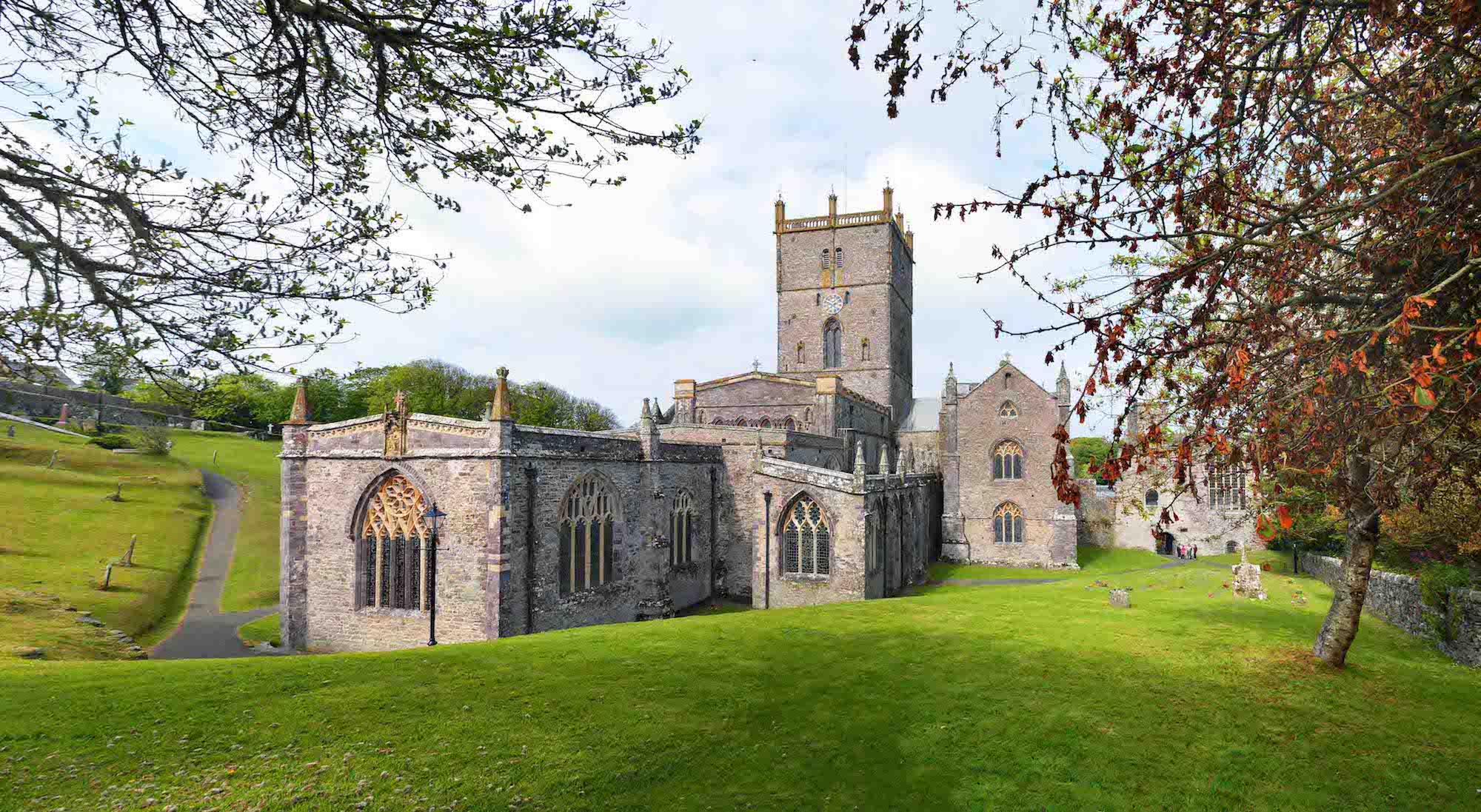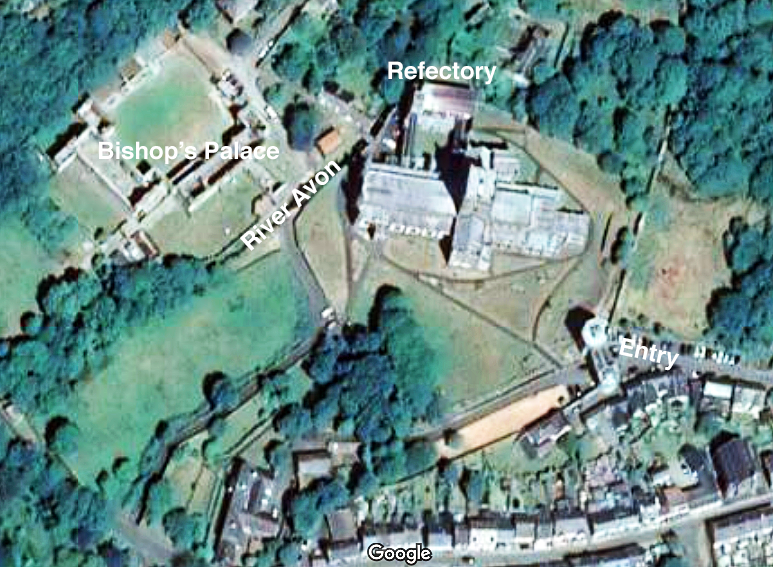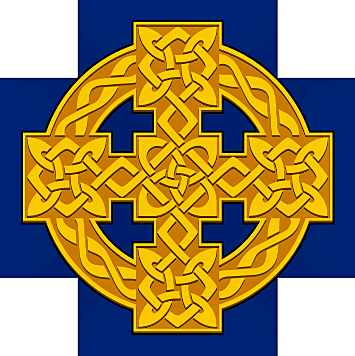 WELCOME TO
WELCOME TO
ST DAVIDS CATHEDRAL
ST DAVIDS WALES
PAUL SCOTT
SATELLITE VIEW
The short walk from the city of St Davids brings us to the entry gatehouse. The Cathedral in its beautiful parklands, now spreads out below us. The picturesque ruins of the Bishop’s Palace can be seen on the left. The axis of the cathedral is almost exactly east-west, so we easily identify our geographical and liturgical directions. The Cathedral is essentially cruciform in shape with a large square central tower. A chapel branches off from the North transept, and there is a cloister on the North side with the refectory on the boundary. We shall find this foils our attempt to walk right around the outside of the Cathedral! There is an entry door at the Southwest corner of the nave.

This is the plan supplied by the Cathedral. As part of our exploration of the exterior we shall check out the cloisters, and of course the refectory! Then, after entering the nave by the South door at bottom right, we shall explore the Cathedral following the numbers given here. The Eastern (upper) end of the Cathedral is quite complex in its layout, so it may be helpful to refer back to this plan from time to time.
The plan is interesting because it shows how the Cathedral has been added to over the centuries.
You can access intermediate points in the tour by a tap / click on the following links:
A brief history follows. To continue an investigation of the Cathedral building and surrounds, start with START!
NOTE ON MAGNIFYING IMAGES
With this website format the images are large enough for most purposes. If there is a need for greater magnification of an image, go to the identical photo on
https://www.flickr.com/photos/paulscottinfo/albums
and use Command - + (Mac) or Windows - + (Windows).

HISTORY
[Wikipedia]
- Older History
- The monastic community was founded by Saint David, Abbot of Menevia, who died in 589. Between 645 and 1097, the community was attacked many times by raiders, including the Vikings, however it was of such note as both a religious and intellectual centre that King Alfred summoned help from the monastic community at St Davids in rebuilding the intellectual life of the Kingdom of Wessex. Many of the bishops were murdered by raiders and marauders, including Bishop Moregenau in 999 and Bishop Abraham in 1080. The stone that marked his grave, known as the “Abraham Stone”, is intricately carved with early Celtic symbols and now on permanent display within the Cathedral Exhibition at Porth-y-Tŵr.
- In 1081, William the Conqueror visited St Davids to pray, and thus recognised it as a holy and respected place. In 1089, the shrine of David was vandalised and stripped of its precious metals. In 1090, the Welsh scholar Rhigyfarch wrote his Latin Life of David, highlighting David’s sanctity, thus beginning the almost cult-like status he achieved.
- In 1115, with the area under Norman control, King Henry I of England appointed Bishop Bernard as Bishop of St Davids. He began to improve life within the community, and commenced construction of a new Cathedral. In 1123, Pope Calixtus II granted Bishop Bernard’s request to bestow a papal privilege upon St Davids, making it a centre of pilgrimage for the Western world, the Pope decreeing that “Two pilgrimages to St Davids is equal to one to Rome, and three pilgrimages to one to Jerusalem". The new Cathedral was quickly constructed and Bishop Bernard consecrated it in 1131. Henry II of England‘s visit in 1171 saw the following of David increase and the need for a larger Cathedral.
- The present Cathedral was begun in 1181 and completed not long after. Problems beset the new building and the community in its infancy, with the collapse of the new tower in 1220 and earthquake damage in 1247/48.
- Under Bishop Gower (1328–1347) the Cathedral was modified further, with the rood screen and the Bishops Palace intended as permanent reminders of his episcopacy. (The palace is now a picturesque ruin.)
- In 1365, Bishop Adam Houghton and John of Gaunt began to build St Mary’s College and a chantry. He later added the cloister, which connects it to the Cathedral.
- The episcopacy of Edward Vaughan (1509–1522) saw the building of the Holy Trinity chapel, with its fan vaulting which some say inspired the roof of King’s College, Cambridge. This period also saw great developments for the nave, whose roof and Irish oak ceiling were constructed between 1530 and 1540. Bishop Barlow, unlike his predecessor as bishop, wished to suppress the following of David, and stripped St David’s shrine of its jewels and confiscated the relics of St David and St Justinian in order to counteract “superstition” in 1538. In 1540, the body of Edmund Tudor, Earl of Richmond and father of Henry VII, was brought to be entombed in front of the high altar from the dissolved Greyfriars’ Priory in Carmarthen.
- The establishment of the Commonwealth of England under Oliver Cromwell had great effect on many Cathedrals and churches, particularly felt in St Davids. The Cathedral was all but destroyed by Cromwell’s forces and the lead was stripped from the Bishops Palace roof.
- Present Cathedral
- The Welsh architect John Nash was commissioned to restore the west front in 1793 to repair the damage done two hundred years previously. Eclectic in style (with Gothic and Perpendicular characteristics – the latter attributed partly to his destruction of the windows of the chapel of St Mary’s College in order to reuse that tracery for his west front), his work soon proved to be substandard (as had his previous work on the chapter house). Within a century the Nash west front had become unstable and the whole building was restored by George Gilbert Scott between 1862 and 1870. The lady chapel was restored by public subscription in 1901 and the eastern chapels were restored through a legacy of the Countess of Maidstone, granddaughter of Bishop John Jenkinson, between 1901 and 1910.
- The Cathedral suffered the pains of disestablishment in 1923, as did the whole Church in Wales. The diocese was made smaller by the removal of the Archdeaconry of Brecon to form the new Diocese of Swansea and Brecon. However, this left a large area as a diocese to govern and St Davids began to deteriorate as the centre of the diocese, being nowhere near the centre – the bishop’s residence had been at Carmarthen since the 16th century, but administration and the focus moved from the Cathedral to the diocese’s now largest town.
- The 1950s saw the appointment of the Reverend Carl Witton-Davies as dean; appointed in his thirties, his driving vision and energy was short-lived as he was offered what some was believed as a preferment as Archdeacon of Oxford, but did not leave that position for the rest of his service in the church. The Cathedral began to have life again and the famous Welsh Youth Pilgrimages to St Davids (Cymry’r Groes) led many to a life of service in the church and provided the Church in Wales with inspired clergy for a decade following. It was Grade I-listed by Cadw in 1951.
- The 1960s saw the restoration of St Mary’s College as the Cathedral hall, for the use of the Cathedral parish and for use as an area for art exhibitions and poetry readings. It was dedicated by Archbishop Edwin Morris in 1966 and the inaugural event was a poetry reading by the renowned poet R. S. Thomas, who served as a vicar in the Bangor diocese.
- During the 1980s a number of official events in Cathedral life took place: in 1981, Charles, Prince of Wales visited to celebrate the 800th anniversary of the consecration of the Cathedral; and on Maundy Thursday 1982, Queen Elizabeth II distributed the Royal Maundy at the Cathedral. This was the first occasion that the ceremony had taken place outside England. In 1989–90, the 1400th anniversary of the death of St David was presided over by the Archbishop of Wales, George Noakes, who was also diocesan Bishop of St Davids.
- The decades leading to and immediately following the year 2000 have been the most notable in the Cathedral’s history since its construction. Firstly, the British Government decided to reinstate the title of “city” to St Davids and this was formally conferred by Queen Elizabeth II on 1 June 1995. The task that lay before the dean, the Very Reverend Wyn Evans, on his appointment in 1994 was huge: a new organ was badly needed and the west front needed extensive restoration. It was also thought time that the Cathedral invested in its future by creating a visitor centre within the bell tower, enlarging the peal of bells from eight to ten and by the “reconstruction”, or completion, of the Cathedral cloisters to house the Cathedral choir, vestries, an education suite, rooms for parish use and a refectory as a reminder of the monastic beginnings. The first project was the restoration of the west front, with the original quarry that was used for stone at Caerbwdi Bay being reopened. This phase was completed in 1998, in time for the organ to be dismantled and rebuilt by the organ builders Harrison and Harrison of Durham. The organ was completed in the middle months of 2000 and dedicated on 15 October that year.
- The ring of bells was cast by Whitechapel Bell Foundry of London and presented as a gift by the American Friends of St Davids Cathedral. The substantial task of rebuilding the cloisters as an education centre and refectory began in 2003 and was completed in May 2007. The translation of Wyn Evans from dean to bishop led to the appointment of Jonathan Lean as dean in 2009.
- https://en.wikipedia.org/wiki/St_Davids_Cathedral


